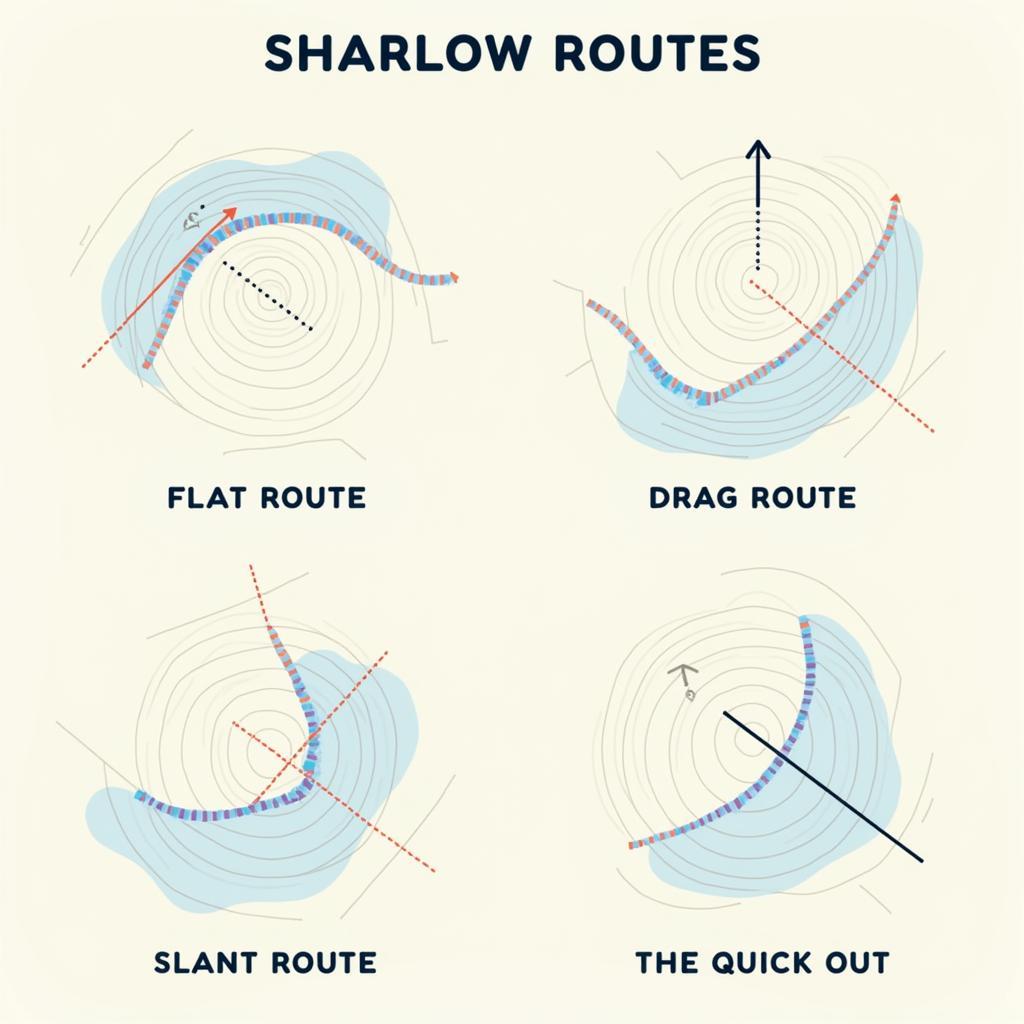Shallow Route Football is a crucial aspect of any offensive playbook, offering quick passing options that can exploit defensive vulnerabilities and keep the chains moving. Understanding the nuances of these short-range passing plays, both as a quarterback and a receiver, can significantly enhance your team’s offensive prowess. We’ll explore the intricacies of shallow routes, from their strategic advantages to the techniques needed for successful execution. Let’s dive in!
Decoding the Shallow Route: Purpose and Positioning
Shallow routes are typically run within 5-10 yards of the line of scrimmage, often targeting the area between the linebackers and defensive backs. They provide a safe and effective outlet for quarterbacks facing pressure, allowing for quick completions and minimizing the risk of sacks. These routes are particularly effective against zone defenses, exploiting the gaps in coverage and creating mismatches.
The key to a successful shallow route lies in precise route running and timing. Receivers need to burst off the line of scrimmage, find the soft spot in the zone, and present a clear target for the quarterback. Quarterbacks, in turn, must make quick reads, deliver the ball accurately, and trust their receivers to make the play.
After the initial catch, the receiver’s role transitions from route runner to ball carrier. Turning upfield quickly and maximizing yards after the catch (YAC) is critical for turning short gains into significant advances.
Check out this article on routes that effectively beat Cover 3: what routes beat cover 3.
Shallow Route Variations and their Strategic Applications
While the basic concept of a shallow route remains consistent, variations exist to exploit different defensive schemes and personnel matchups. Some common shallow route variations include the flat route, the drag route, the slant route, and the quick out. Each route presents a unique angle of attack, challenging the defense to react quickly and effectively.
The flat route, for example, targets the sideline area, stretching the defense horizontally and creating space for other routes. The drag route, on the other hand, cuts across the middle of the field, exploiting gaps in zone coverage and providing a reliable option on crucial third downs.
Understanding when to employ each variation is crucial for maximizing the effectiveness of shallow routes. Factors such as the defensive alignment, down and distance, and the receiver’s skill set all play a role in determining the most appropriate route choice.
 Different Shallow Route Variations in Football
Different Shallow Route Variations in Football
Executing the Shallow Route with Precision
Executing a successful shallow route requires a combination of physical skill and mental acuity. Receivers need to possess excellent footwork, agility, and the ability to adjust their route based on the defensive coverage. Quarterbacks need to demonstrate quick decision-making, accurate throwing, and a strong understanding of the offensive scheme.
For receivers, getting a clean release off the line of scrimmage is crucial. Using proper technique to beat press coverage and create separation allows the quarterback a clear throwing window. Maintaining awareness of the defender’s position and adjusting the route accordingly is essential for maximizing the chances of a successful completion.
Quarterbacks, meanwhile, need to anticipate the receiver’s break and deliver the ball on time and in stride. A well-timed throw allows the receiver to catch the ball in rhythm and transition smoothly into yards after the catch. Effective communication between the quarterback and receiver is essential for ensuring proper timing and execution.
Looking for effective plays against Cover 2 Man? Explore our guide on cover 2 man beaters.
Conclusion: The Power of the Shallow Route
The shallow route, while seemingly simple, is a powerful weapon in any offensive arsenal. Its ability to exploit defensive vulnerabilities, generate quick completions, and create opportunities for yards after the catch makes it a valuable tool for moving the ball and scoring points. By mastering the nuances of shallow routes, both quarterbacks and receivers can significantly enhance their team’s offensive performance and dominate the gridiron.
FAQs
- What is the typical depth of a shallow route in football? (Typically 5-10 yards)
- Why are shallow routes effective against zone defenses? (They exploit gaps in coverage.)
- What are some common variations of the shallow route? (Flat, drag, slant, quick out)
- What are key skills for receivers running shallow routes? (Footwork, agility, route adjustment)
- What are key skills for quarterbacks throwing to shallow routes? (Quick decision-making, accurate throwing)
You can learn more about how to beat Cover 3 with our guide on beat cover 3 and another useful resource on cover 3 robber. Also, check out this resource on cover 3 beater.
For support, contact us at:
Phone: 0902476650
Email: [email protected]
Address: 139 Đ. Võ Văn Kiệt, Hoà Long, Bà Rịa, Bà Rịa – Vũng Tàu, Việt Nam.
We have a 24/7 customer support team.





